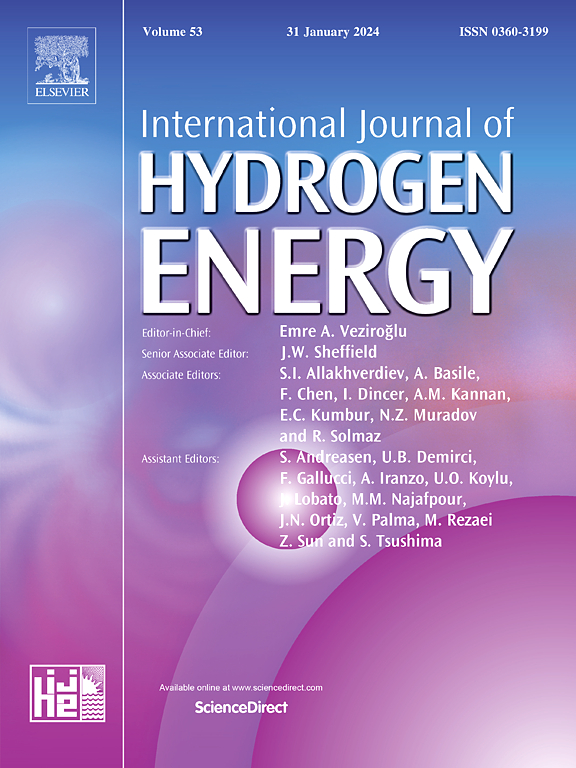Effects of nanoparticles and ozone pre-treatments on dark fermentation of biosolids and wine vinasses
IF 8.3
2区 工程技术
Q1 CHEMISTRY, PHYSICAL
引用次数: 0
Abstract
This study investigates the impact of carbon-encapsulated zero-valent iron (ZVI) nanoparticles, both independently and in combination with ozone pre-treatment, on the batch and semi-continuous dark fermentation of biosolids and wine vinasses in a thermophilic reactor (55 °C). The study focuses on the production of volatile fatty acids (VFA) and hydrogen, as well as the dehydratability of the digestate.
The pre-treatment with ZVI nanoparticles does not result in an overall increase in total acid production. However, it does affect the VFA profile by promoting the formation of long chain acids (C ≥ 4), notably resulting in a 37 % increase in butyric acid yield (mg/gVSadded). In terms of hydrogen yield, the use of ZVI nanoparticles shows no discernible effect. However, a significant increase in carbon dioxide yield is observed, reaching a 129 % rise compared to the control, expressed as mL/gVSadded. When combining the dosage of ZVI nanoparticles with ozone, there was observed a noticeable effect on hydrogen yield, leading to an increase (e.g. 125 %). Regarding with the dehydratability of the digestate, the pre-treatments with ZVI nanoparticles, as well as the combination of the ZVI nanoparticles with ozone, enhanced the dehydratability of the digestate by reducing the specific resistance of the cake which facilitates the subsequent waste processing.

纳米颗粒和臭氧预处理对生物固体和葡萄酒发酵的影响
本研究研究了碳包封零价铁(ZVI)纳米颗粒对生物固体和葡萄酒的分批发酵和半连续发酵的影响,无论是单独的还是与臭氧预处理相结合的。研究的重点是挥发性脂肪酸(VFA)和氢的产生,以及消化液的脱水性。ZVI纳米颗粒的预处理不会导致总酸产量的总体增加。然而,它确实通过促进长链酸(C≥4)的形成来影响VFA谱,特别是导致丁酸产率增加37% (mg/gVSadded)。在产氢率方面,ZVI纳米颗粒的使用没有明显的影响。然而,观察到二氧化碳产量显著增加,与对照相比增加了129%,以mL/gVSadded表示。当ZVI纳米颗粒与臭氧的剂量相结合时,观察到对氢气产率的显著影响,导致增加(例如125%)。对于消化液的脱水性能,ZVI纳米颗粒的预处理,以及ZVI纳米颗粒与臭氧的结合,通过降低饼的比阻来增强消化液的脱水性能,有利于后续的废物处理。
本文章由计算机程序翻译,如有差异,请以英文原文为准。
求助全文
约1分钟内获得全文
求助全文
来源期刊

International Journal of Hydrogen Energy
工程技术-环境科学
CiteScore
13.50
自引率
25.00%
发文量
3502
审稿时长
60 days
期刊介绍:
The objective of the International Journal of Hydrogen Energy is to facilitate the exchange of new ideas, technological advancements, and research findings in the field of Hydrogen Energy among scientists and engineers worldwide. This journal showcases original research, both analytical and experimental, covering various aspects of Hydrogen Energy. These include production, storage, transmission, utilization, enabling technologies, environmental impact, economic considerations, and global perspectives on hydrogen and its carriers such as NH3, CH4, alcohols, etc.
The utilization aspect encompasses various methods such as thermochemical (combustion), photochemical, electrochemical (fuel cells), and nuclear conversion of hydrogen, hydrogen isotopes, and hydrogen carriers into thermal, mechanical, and electrical energies. The applications of these energies can be found in transportation (including aerospace), industrial, commercial, and residential sectors.
 求助内容:
求助内容: 应助结果提醒方式:
应助结果提醒方式:


